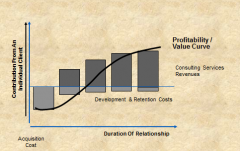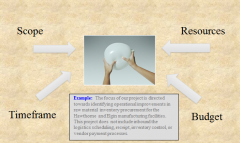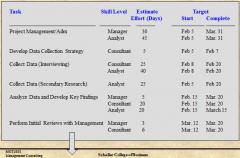![]()
![]()
![]()
Use LEFT and RIGHT arrow keys to navigate between flashcards;
Use UP and DOWN arrow keys to flip the card;
H to show hint;
A reads text to speech;
36 Cards in this Set
- Front
- Back
|
Sourcing Engagements (Initiating Contact)
|
Account Manager (Partner/Director) Developed
Referrals/Client Initiates Contact Responding to Requests for Proposals (“RFP”) |
|
|
Account Manager (Partner/Director) Developed
|
Long-Term Relationships
Target Marketing Cold Calling (Rarely creates immediate project work – but if done well can help create recognition) |
|
|
Referrals/Client Initiates Contact
|
Qualifying the opportunity
Understanding the motivation and project status |
|
|
Responding to Requests for Proposals (“RFP”)
|
Proposal Investment is typically at risk although RFP requirements may be
significant (often a low probability of acceptance) Success rates here will be typically low (without some pre-existing relationship) |
|
|
The Life Time Value of a Client
|

|
|
|
Selling Consulting Services
|
For the Most Part Consultants are Delivering an Intangible Product (Notable Exception: Consultants who are Selling IT Hardware or Application Software Solution)
The Deal is Shaped and Won Through Personal Selling Techniques Critically Important are: TRUST (The Client MUST BELIEVE that YOU and the FIRM YOU Represent are the Answer to Their Problem) Existing Relationships (between the Clients organization and YOU and/or the FIRM) Brand (if existing relationships do not already exist) For Government and Price Sensitive Clients the “value” is different – low cost often becomes the deciding factor It’s everyone’s responsibility to sell (at the junior level its about professionalism, demonstrating competence, and being alert to opportunities to turn over to more senior people) |
|
|
Who is the Real Client -- Organizational Influence Map
|

|
|
|
Developing Business
|
Starting point for client engagements
Critical to identify the right client issues and optimal working relationship Client/consultant behaviors during this phase will model those behaviors that will demonstrated during the engagement phase That said .. to the maximum extent making make the proposal process Collaborative - don’t sell the client, instead solution the client |
|
|
Developing business is about..
|
About gathering facts, analyzing the client’s situation, and crafting a theory of the problem
|
|
|
Formality depends on:
|
How well the consultant and client know each other.
Expectations from the project. Level of resources committed to the project by the client. Investment by the consultant in making the formal proposal. Need to communicate within the client business. Need to inform third parties |
|
|
Important to reach a consensus about key project ...
|
parameters and establishing nature of working relationship
|
|
|
Initial Contact
Begin a Professional Relationship Develop an Understanding of the “Request” What are the two aspects? |
1)Course of Action that
Requires an Understanding Of a Situation or Problem Being Experienced by the Client 2)Simple/Obvious Course of Action (That May Require Some Clarification) |
|
|
The Needs Assessment
|
The purpose of conducting a needs assessment in the developing business phase to frame and define the client's problem. Typically a needs assessment also includes understanding the gap or difference (functional, technological, financial, market, human resources, etc.) between the current state and a future desired state
|
|
|
A Needs Assessment Addresses the Following
|
Current situation and how they got there
Dimensions and dynamics of the current situation What a future state is needed (the objective) Practical features or specifications of the future state Internal and external factors causing the gap and any causal factors. Factors driving and hindering closing the gap (force field analysis) Other project related expectations How does the client want us to work with the organization (roles) What is the client's personal exposure (career or power concerns) What do we need to do to exceed the client’s expectations |
|
|
Gathering Facts -- Interviews
|
The needs assessment typically involves interview(s)
as the primary form of data collection |
|
|
Closed Questions
|
Lead to yes or no answers (or a selection among alternatives). Pins the client down.
Usually asked about preferences or specific requirements. Also use when you have a limited amount of time. Can be used to interrupt a long-winded answer. |
|
|
Open Questions
|
Requires the client to open up, explain, describe, elaborate, expand, with the intent to provide a lot of information. Example: The 5 whys. Or questions that begin with describe, or explain, etc.) Key to gaining an understanding or rationale. The downside is that a client can go off on a long unproductive tangent.
|
|
|
Leading Questions
|
Leads to an answer that the consultant wants. Example: “Don’t you think its time to eliminate that data entry function?” Can be useful but use with caution. They may be perceived as pushy, arrogant (especially in the early stages of a relationship). Consider softening by saying “ if you don’t mind me saying ….”.
|
|
|
Loaded Questions
|
Don’t use – clear sign of inexperience. Loaded questions are leading questions questions that usually convey a negative judgment. “Wouldn't it be smarter if we just eliminated this function”. Better approach “What would be the implications if this function were eliminated?”. Then drive down with the 5 whys if necessary. Loaded questions make the client uncomfortable.
|
|
|
A Framework For Asking Questions
|
Situation Questions
Problem Questions Implication Questions Need-Payoff Questions |
|
|
Situation Questions
|
these questions are directed towards understanding the size, scale, and scope of the situation to be dealt with. Examples: What is your
current profitability by product line (total gross margin, gross margin %)?What is your targeted level of profitability by product line? |
|
|
Problem Questions
|
– these questions focus on the precise nature of the problem including key business/technical/political issues. Examples: To what extent have profit margins eroded over the last three years and would the erosion be attributed to 1) rising manufacturing costs 2) pricing decisions, and/or 3) changes in market
|
|
|
Implication Questions
|
these questions are intended to have the client think about the problem from a different perspective. Example: If the company decided to eliminate the unprofitable Eco Skis line of products, how would that impact your
co-marketing relationship with Patagonia |
|
|
Need-Payoff Questions
|
these questions examine potential solutions and the clients reaction to those solutions. Example: How would it help if you implemented an automated customer scoring system.
|
|
|
Before You Get Carried Away with Problem Definition Remember ...
|
The request may be for a simple provision of a service
(e.g. facilitating an off site meeting, or developing a comparative analysis (benchmark) of some product or capability relative to the competition, or to provide a resource to fill a gap); or The purpose of the project may be to better identify the problem and then develop recommendation for a more specific analysis So you your expertise and/or common sense to determine when its actually necessary to drill down into problem definition |
|
|
The Proposal
|
Proposals can be as informal as a oral conversation with a follow-up eMail (think Internal Consultant) to a multi-volume document delivered in a large trunk (think response to a massive RFP)
The effort put into the proposal should be related to the size (typically thought of in terms of potential fees) of the opportunity A best practice to to have the more complex proposal developed as a joint effort that included prospective client participation. In some cases the client will be eager to help out (particularly if the client and consultants have a long term relationship already) in other cases not (more often the norm in terms of developing responses to RFPs) |
|
|
Project Related Expectations
|
client related
consultant related |
|
|
Client Expectations
|
Quality standards and quality metrics
Adherence to client standards and methodologies Updates and status reports Completion dates Knowledge transfer Other (can be anything – you have to ask |
|
|
Consultant Expectations
|
Use of client personnel, facilities and equipment
Access to needed participation (from client personnel) Access to client information and secondary data sources Timely decision-making Prompt payment of invoices Use of client as a reference Ownership of Intellectual Property created by the engagement for firm use |
|
|
Developing the Proposal
|
Perform a needs assessment
Develop a solution hypothesis Determine firms knowledge capital (appropriate to the problem) With the client: continue to meet jointly define problem/issues negotiate around constraints agree to work approach and timeframes |
|
|
The Proposal Document (Dos and donts)
|
Dos:
Be persuasive Must contain “Client-Focused” Content Demonstrate an understanding of the customers needs Focus on the results (goals) Keep it simple. Avoid jargon, too much technical detail (unless specifically requested) Keep credentials brief and relevant. Differentiate yourself Don’ts: Be generic Just provide an “information dump” Forget to carefully read, edit, spell check, use good grammar |
|
|
The Proposal Document
|
Introductory Paragraph
(firm appreciates the opportunity to propose on the ______ project) Background (demonstrate an understanding of the client’s problem and the activities that led up to the development of the proposal. This section will typically lay out the project “scope”, e.g. what’s included, sometimes what’s not included) Objectives and Expected Benefits (to solve a problem, to provide knowledge transfer, etc. Whatever was agreed to and what must be delivered to meet client expectations) Project Plan (work approach (methods), major tasks, responsibilities, and important deliverables. Will also include statements regarding how the project will be managed) Timetable (usually a milestone chart with explanation) Fees and Expenses (includes clients costs and any terms of payment. Typically expenses are charged at actual and maybe capped at a % of fees. Fees may be stated as an hourly rate or for an entire project. If project fees are stated then they may be capped at a specific amount, or open ended and indicated as an approximation only) Qualifications (explains why the firm is best qualified to assist with the project) Ending/Signature Block (usually a statement of commitment to the client; signed by an officer of the consulting firm) |
|
|
Project Planning
|

|
|
|
Sample Workplan
|

|
|
|
Terms and Conditions
|
If proposal is for an existing client, then its likely that an existing Master
Agreement is in Place. The proposal letter just refers to the MA and notes any Exceptions specific to the proposed work. In effect the proposal is for another Statement of Work (“SOW”). Important Terms include: Confidentiality Termination Intellectual Property Ownership (Rights to materials) Limitations of Liability If a MA does not exist or if the proposal is for a prospective client, then typically a standard contract is submitted with the proposal. During subsequent negotiations, lawyers for the firm and client deal with the contractual language while the consultant and the client focus on the “business aspects” of the proposal |
|
|
Internal Consultants
|
May or may not use proposals and “arrangement letters” however typically is a best practice to do so. In either case the process and documents are less formal than for 3rd party independent consultants.
Generally would not include qualifications statement and fees unless chargeback model used in which case an estimate of costs would be appropriate |

